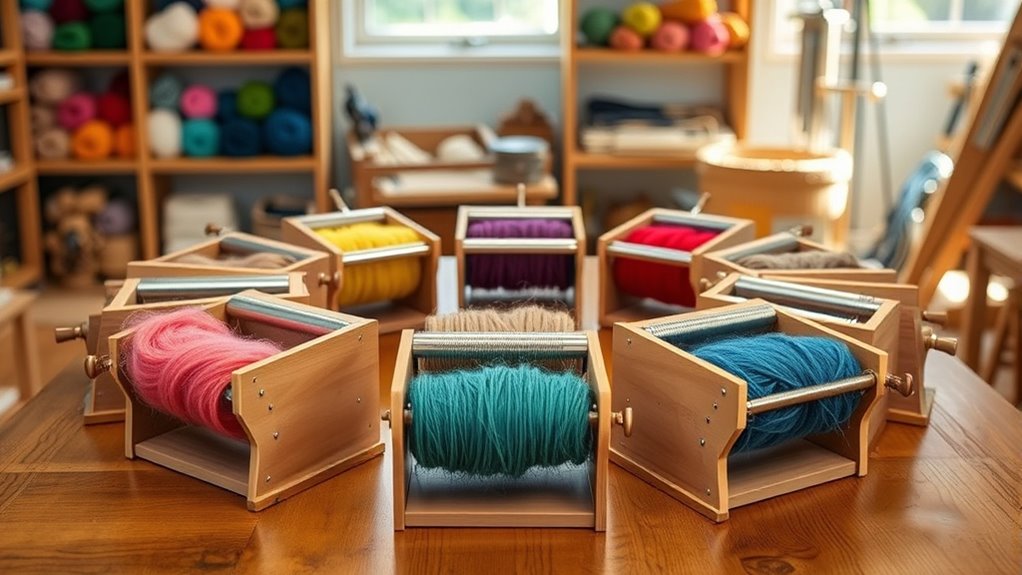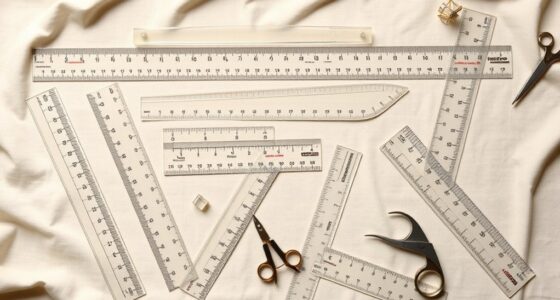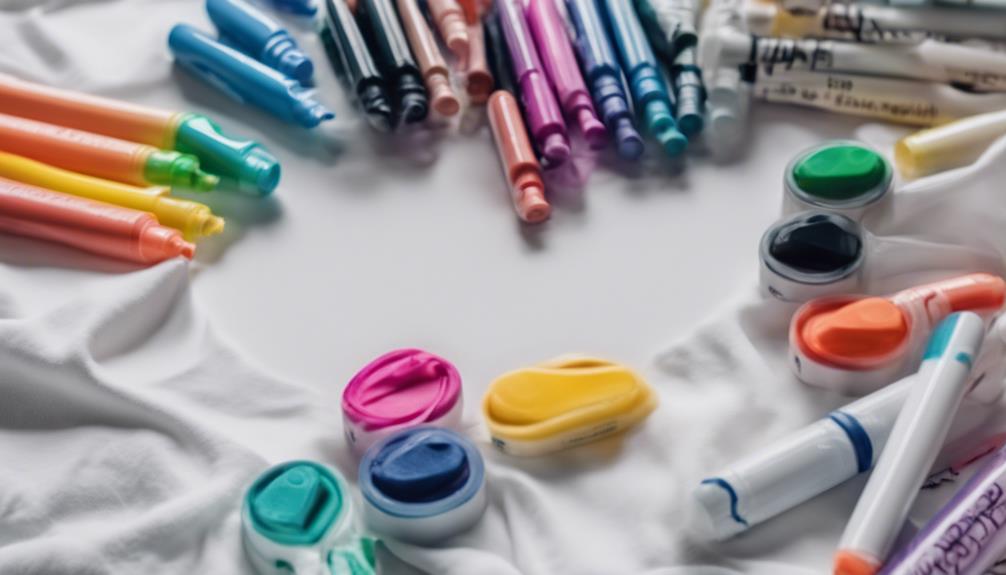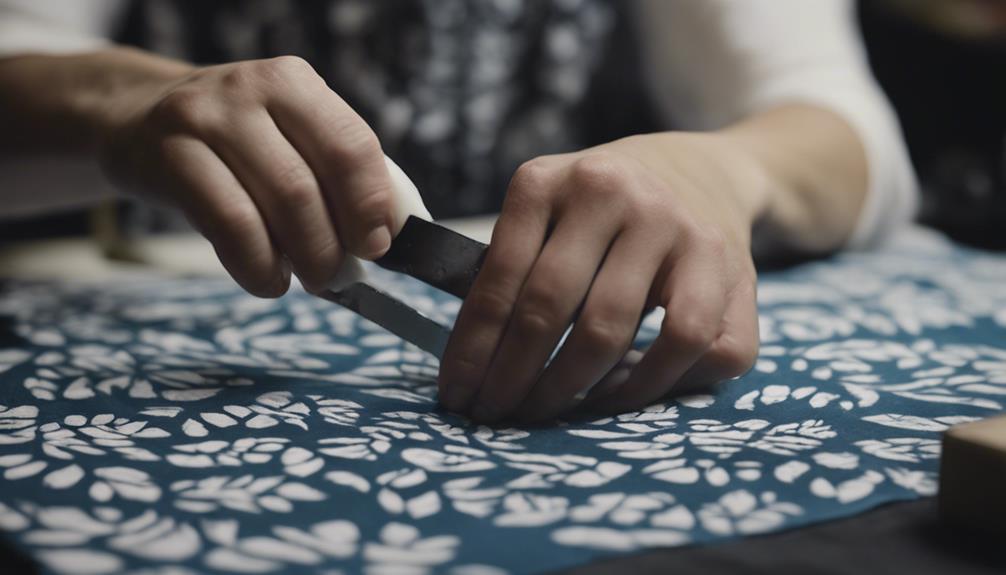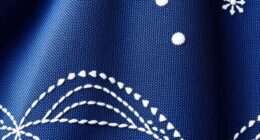If you’re looking for the best drum carders in 2025, I recommend options like the Ashford Wild Drum Carder and the 12 Wide Drum Carder Fine for versatile fiber blending. The Ashford Superfine and Wool Fiber Carder are great for fine, textured batts. Consider models with adjustable ratios, durable frames, and different wire TPI to match your fiber types. Keep exploring to find out which one fits your needs for smooth, efficient spinning.
Key Takeaways
- Consider drum width, wire TPI, and adjustable ratios for optimal fiber blending and batt quality.
- Look for durable materials like hardwood frames and coated wire teeth for long-term performance.
- Evaluate portability features such as weight, handles, and compact design for ease of use and transport.
- Check compatibility with accessories like doffers and cleaning tools to maintain efficiency.
- Prioritize models with versatile features, including interchangeable drums and fine wire options, for various fiber types.
Ashford Wild Drum Carder

If you’re looking for a versatile drum carder that allows you to blend a variety of fibers and materials with ease, the Ashford Wild Drum Carder is an excellent choice. It’s perfect for creating vibrant, textured batts by blending fibers, fabrics, ribbons, feathers, and even paper. With a 4-inch carding width and a 12-inch carder width, it offers a good balance of portability and capacity. Its fine wire teeth coated for durability make for smooth, controlled blending. Plus, features like adjustable clearance and nylon bearings ensure easy operation. Compact and lightweight at just 7.5 pounds, it’s ideal for both beginners and experienced fiber artists.
Best For: fiber artists and crafters seeking a versatile, portable drum carder for blending fibers, fabrics, and alternative materials to create unique textured batts.
Pros:
- Easy to operate with adjustable drum clearance for better control
- Durable wire teeth coated for longevity and smooth blending
- Compact and lightweight design ideal for portability and storage
Cons:
- Limited carding width of 4 inches may require multiple passes for larger projects
- Capacity of 1.5 ounces per batch might be slow for large-scale production
- Some users may find the manual operation less efficient for high-volume work
Ashford Drum Carder Fine
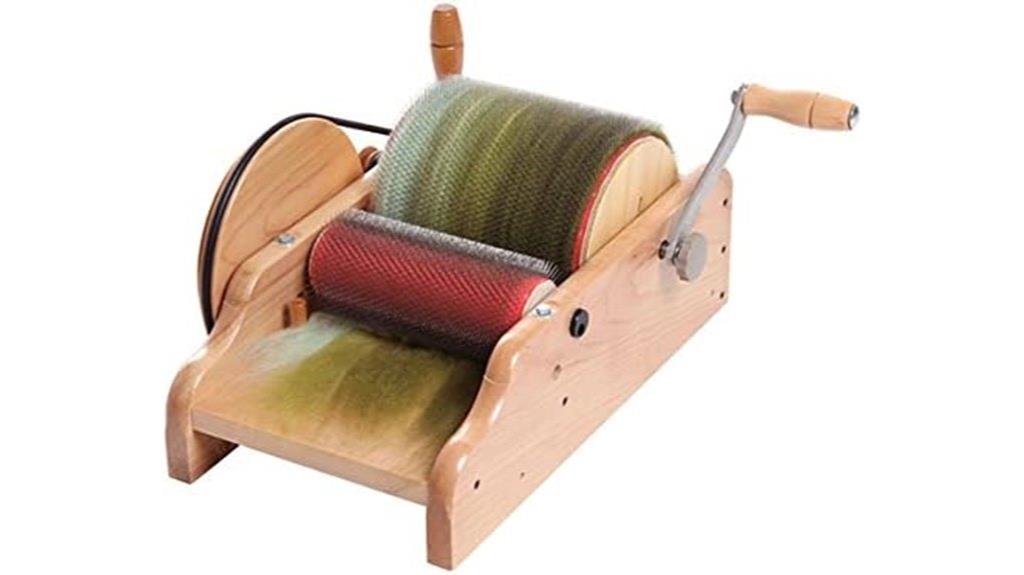
Looking for a drum carder that simplifies fiber preparation without sacrificing quality? The Ashford Drum Carder Fine is an excellent choice. It features a fine carding cloth with 72 points per square inch, making blending and color creation effortless. Fully assembled and user-friendly, it offers two ratio options—6:1 and 4:1—for versatile processing. Made from durable New Zealand Beech hardwood with a lacquer finish, it’s built to last. The large drum diameter and adjustable clearance ensure consistent results, while included accessories like a packer brush and cleaning tools make maintenance straightforward. Overall, it’s a reliable, efficient tool for smooth fiber prep.
Best For: fiber artists and spinners seeking a durable, versatile drum carder for effortless blending and fiber preparation.
Pros:
- Easy to use with fully assembled, user-friendly design
- High-quality construction from durable New Zealand Beech hardwood
- Adjustable clearance and two ratio options for versatile processing
Cons:
- Relatively heavy at 11 lbs (5 kg), which may be less portable
- Larger size might require dedicated space for operation
- May have a higher price point compared to basic models
Ashford 12 Wide Drum Carder Fine
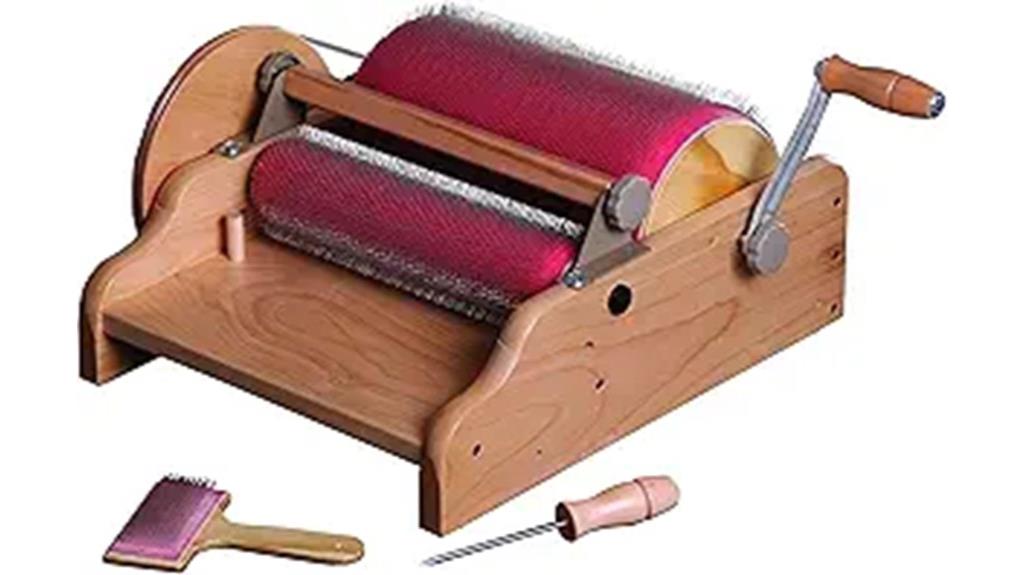
The Ashford 12 Wide Drum Carder Fine stands out for fiber artists who need precise control over blending fibers and colors. Its 12-inch wide cloth with 72 PPSI wire teeth efficiently produces 100g batt batches, perfect for detailed projects. The adjustable drum clearance lets me customize the teeth distance, ensuring smooth, even batt creation. With two-speed settings (4:1 and 6:1), I can adjust the carding intensity to suit different fibers and techniques. Made from durable Silver Beech hardwood, it’s lightweight yet sturdy. The included doffer, clamps, packer brush, and cleaning brush make the process straightforward. Overall, it’s a reliable, versatile tool for high-quality fiber prep.
Best For: fiber artists and spinners seeking precise, adjustable blending of fibers and colors for high-quality batt production.
Pros:
- Efficiently produces smooth, even batt batches up to 100g with adjustable drum clearance for customized fiber blending.
- Durable construction from Silver Beech hardwood with wire teeth coated for longevity and easy maintenance.
- Dual-speed operation (4:1 and 6:1) offers versatility for different fibers and project needs.
Cons:
- Weighs only 4 ounces, which may make it less stable without proper handling or support during operation.
- Limited to 12-inch wide fiber processing, which might be insufficient for larger projects.
- Some users might find the manual adjustment of drum clearance requires careful handling for optimal results.
Drum Carder – Superfine by Ashford
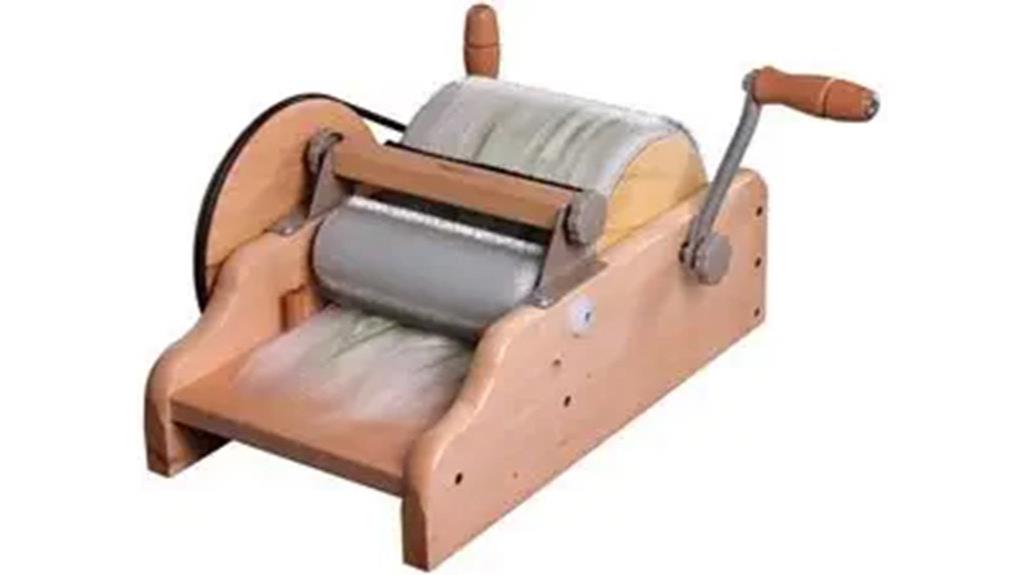
When choosing a drum carder for fine fiber preparation, the Drum Carder – Superfine by Ashford stands out with its superfine 120-point wire teeth designed for precision and durability. Made from sturdy Silver Beech hardwood, it’s lightweight yet robust, with rubber feet to prevent slipping. The carder includes helpful accessories like a packer brush and cleaning tools. Its adjustable drums offer two ratios—6:1 for smooth batt and 4:1 for blending fibers and colors—giving me full control. With its fast, efficient operation and ability to handle up to 50 grams of fiber, it’s ideal for fine fiber projects like alpaca, ensuring consistent, high-quality results.
Best For: fiber artists and crafters who want precise, high-quality fiber preparation for spinning, felting, and blending fine fibers like alpaca.
Pros:
- Features superfine 120-point wire teeth for detailed fiber carding and blending
- Made from durable Silver Beech hardwood with adjustable drums for versatile use
- Lightweight design with rubber feet ensures stability and ease of operation
Cons:
- Handles only up to 50 grams (2 oz) of fiber at a time, which may be limiting for larger projects
- May require some adjustment to optimize drum clearance and ratios for different fibers
- Slightly higher price point compared to basic carders, reflecting its premium features
Drum Carder for Fiber Wool Carder
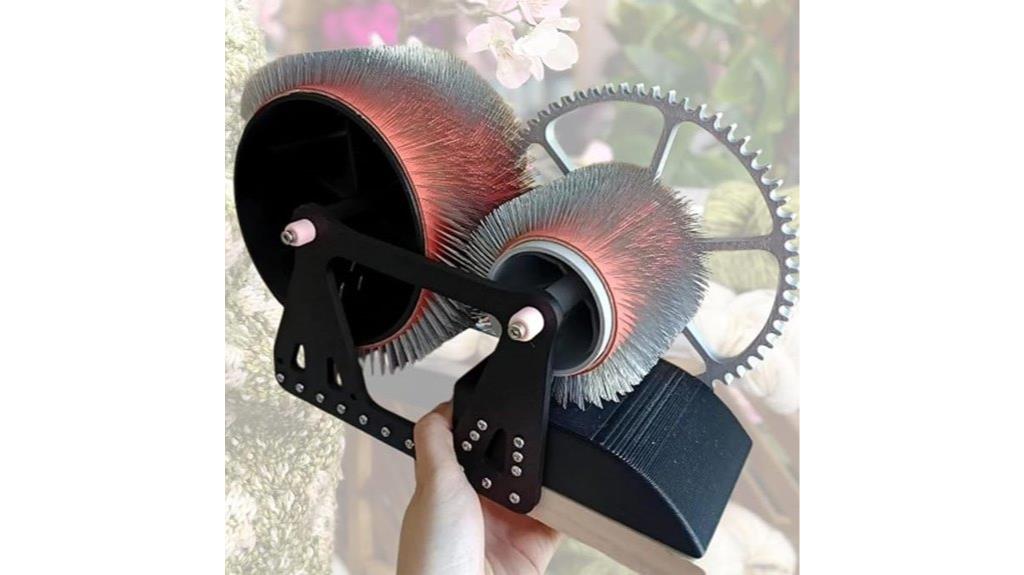
If you want a reliable, manual wool carder that simplifies fiber prep without electricity, this drum carder is an excellent choice. It transforms tangled fibers into smooth, straight strands, removing impurities for high-quality wool crafting. With elastic brushes for superior mixing and blending, it allows quick color blending and fiber combination. Made from lightweight, durable materials like nylon bearings, it’s easy to handle. The new model offers two ratios: 6:1 for fleece preparation and 4:1 for blending fibers and colors into airy batt. Whether for spinning, felting, or fiber mixing, this carder delivers versatile, efficient performance for any fiber artist.
Best For: fiber artists and crafters seeking an energy-efficient, manual wool carding tool for blending, felting, and preparing fibers with ease and precision.
Pros:
- Manual operation eliminates the need for electricity, saving energy and offering sustainable use.
- Features elastic brushes for superior mixing, blending multiple colors and fibers quickly.
- Constructed with lightweight, durable materials like nylon bearings, ensuring ease of handling and longevity.
Cons:
- Requires manual effort, which may be tiring for extended use.
- Limited to specific ratios (6:1 and 4:1), which may not suit all fiber preparation needs.
- Smaller package dimensions may require additional equipment for larger-scale fiber processing.
Drum Carder for Wool Fiber Blending

For fiber artists seeking precise wool blending, drum carders with adjustable ratios excel at creating uniform, customized batt. The model I recommend offers two ratios: 6:1 for controlled fleece preparation and 4:1 for blending fibers, colors, and wool types. This versatility allows me to mix wool with other fibers or combine different colors easily. It transforms tangled fibers into smooth, airy batt, perfect for spinning, felting, or crafting. Made from lightweight, durable materials with nylon bearings, it’s user-friendly and efficient. Whether I’m blending wool or creating vibrant textured batt, this drum carder provides the control and quality I need for professional results.
Best For: fiber artists and crafters seeking precise wool blending and versatile fiber preparation for spinning, felting, and textured projects.
Pros:
- Offers adjustable 6:1 and 4:1 ratios for customized fiber blending and pre-processing.
- Transforms tangled fibers into smooth, airy batt suitable for various crafts.
- Made from lightweight, durable materials with nylon bearings for easy, user-friendly operation.
Cons:
- Manual operation may require more effort compared to electric carders.
- Limited to specific ratios; not suitable for large-scale industrial fiber processing.
- Availability and pricing may vary, requiring online or offline searching for best deals.
Drum Carder 120TPI, Golden Fleece Carders

The Golden Fleece Drum Carder 120 TPI stands out as the top choice for fiber artists who need precise and gentle carding of fine wool, cotton, and delicate fibers. Its birch plywood frame and tempered steel carding cloth ensure durability and smooth operation. The interchangeable drums allow customization for different fibers, making it versatile. It produces consistent batts, ideal for spinning and felting projects. With included accessories like clamps and a cleaning brush, setup is straightforward. Operating quietly thanks to inserted bearings and a poly drive belt, this carder offers high-quality fiber alignment, making it a reliable tool for detailed fiber prep.
Best For: fiber artists and crafters who need precise, gentle carding of fine wool, cotton, and delicate fibers for spinning and felting projects.
Pros:
- Durable birch plywood frame with high-quality tempered steel carding cloth ensures longevity and smooth operation
- Interchangeable drums provide customization for different fiber types, increasing versatility
- Produces consistent batts, facilitating efficient fleece processing and high-quality fiber prep
Cons:
- Slightly higher price point compared to basic carders, which may be a consideration for beginners
- Assembly required upon receipt, including attaching the handle before use
- Limited to specific fiber types; may not be suitable for very coarse or bulky fibers
Drum Carder 72TPI, Golden Fleece Carders

The Golden Fleece 72TPI Drum Carder stands out as an excellent choice for fiber artists who prioritize durability and ease of use. Its sturdy birch plywood frame and tempered steel carding cloth ensure long-lasting performance, while the industrial poly drive belt provides smooth, quiet operation. I appreciate how simple it is to set up—just attach the handle—and the included accessories like table clamps, a doffer pin, a cleaning brush, and Allen keys make it even more convenient. It’s perfect for carding and blending wool and fibers like alpaca and Jacob, producing large, consistent batts with minimal effort. Overall, it’s a reliable, user-friendly tool.
Best For: fiber artists and hobbyists seeking a durable, easy-to-use drum carder for blending and preparing wool and fibers like alpaca and Jacob.
Pros:
- Sturdy birch plywood frame ensures long-lasting durability
- Simple setup with handle attachment and included accessories enhances convenience
- Produces large, consistent batts efficiently with minimal effort
Cons:
- Lacks specific instructions, which may require some initial experimentation for beginners
- No available drum brush attachment for additional fiber cleaning options
- Limited to certain fiber types, may not suit highly specialized fiber processing needs
Wool Drum Carder Fiber Carding Machine

If you’re passionate about fiber arts and want a reliable tool to streamline your wool prep, the Wool Drum Carder Fiber Carding Machine stands out as an excellent choice. It features a wide drum and a wool blending wheel, perfect for combing and blending fibers of different colors or textures. Made from durable aluminum alloy and wood, it’s lightweight, easy to handle, and built for efficient, manual fiber processing. The flexible brushes simplify operation, making it ideal for felting, spinning, or creating unique textures. Whether for personal projects or gifts, this machine offers a sturdy, functional design that delivers smooth, uniform fibers every time.
Best For: hobbyists and fiber artists seeking an easy-to-use, durable manual wool carding machine for blending and preparing fibers for felting, spinning, or craft projects.
Pros:
- Made from durable aluminum alloy and wood, ensuring longevity and sturdy operation
- Lightweight and easy to handle, suitable for DIY projects and portable use
- Facilitates seamless blending of fibers of different colors and textures, enhancing creative options
Cons:
- Manual operation may require more effort compared to electric carders
- Limited to small-scale or personal use, not ideal for large production needs
- May have a learning curve for beginners unfamiliar with fiber carding techniques
Factors to Consider When Choosing Drum Carders for Fiber Prep
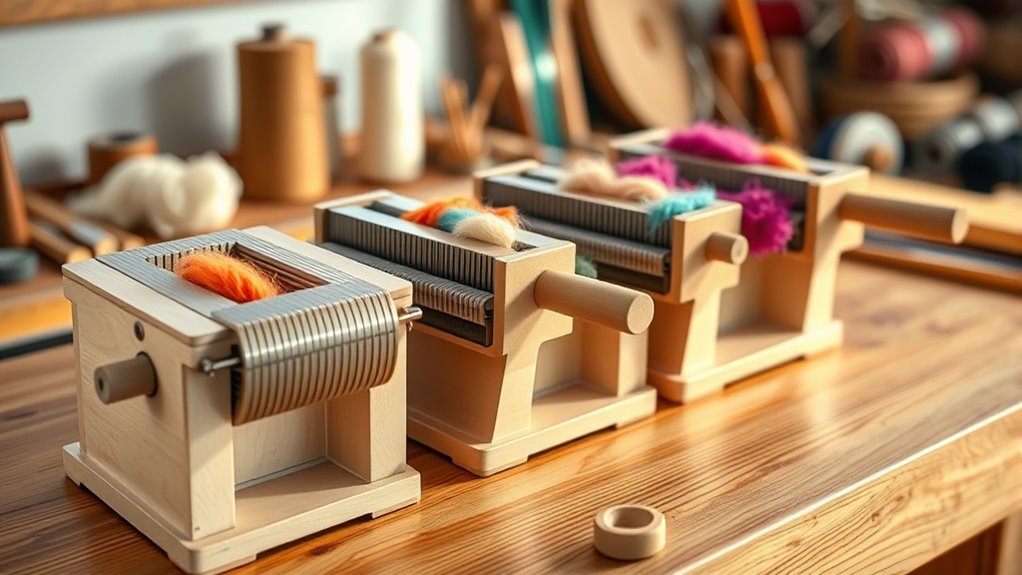
When selecting a drum carder, I consider factors like drum size and width to match my fiber needs, along with TPI and carding cloth for quality results. I also look at ratios and blending options to guarantee versatility, while durability and build quality help me choose a machine that lasts. Ultimately, portability and weight matter for ease of use and transport around my workspace.
Drum Size and Width
Choosing the right drum size and width is essential for efficient fiber preparation. The drum width determines the size of the batt you produce—wider drums create larger, more uniform fibers, ideal for processing bigger batches. Standard widths range from 4 inches for detailed work to 12 inches or more for faster, bulkier fiber prep. A larger drum diameter usually provides smoother fiber flow and handles bulky or long fibers more easily. It also increases capacity, allowing more fiber to be processed per pass, boosting efficiency. Some carders feature adjustable drum widths or interchangeable drums, offering versatility for different projects. Selecting the appropriate size depends on your fiber volume, project scale, and desired fiber uniformity, ensuring smooth, efficient carding tailored to your needs.
TPI and Carding Cloth
The TPI, or teeth per inch, of the carding cloth plays a key role in determining the fineness and texture of your fiber batt. Higher TPI, like 120 TPI, produces finer, more delicate battings, ideal for soft fibers such as silk or fine wool. Conversely, lower TPI, like 72 TPI, is better suited for coarser fibers or thicker blends. The density of the carding cloth influences fiber blending and final texture—finer cloth encourages more thorough fiber separation and smoother results. Additionally, a protective wire coating on the cloth can enhance durability, preventing the teeth from wearing down quickly. The material and quality, whether steel or wire, also affect longevity and effectiveness, ensuring consistent fiber alignment during carding.
Ratios and Blending Options
Different ratios on drum carders, such as 4:1 and 6:1, directly impact how thoroughly fibers are blended. Lower ratios like 4:1 offer more intense mixing, making them ideal for blending multiple fibers or colors into airy layers. Higher ratios, such as 6:1, provide gentler blending, perfect for preparing fleece for spinning by producing smooth, consistent batt. Adjustable ratios give users control over the carding process, allowing customization based on fiber type and project needs. Some drum carders even feature interchangeable drums or adjustable drum clearance, enabling fine-tuning of blending intensity. Understanding these ratio options helps fiber artists select the right setting, whether they want detailed fiber alignment or vibrant, mixed textures, ultimately improving the quality and efficiency of their fiber prep.
Material Durability and Build
When selecting a drum carder, evaluating its material durability and build quality is essential for ensuring long-term performance. I look for models with sturdy frames made from hardwoods like New Zealand Beech or Silver Beech, as these resist warping and cracking over time. The wire teeth should be coated with protective finishes to prevent rust and wear, even with frequent use. A well-constructed frame, often from plywood or hardwood, must be precisely assembled to handle the mechanical stresses of fiber carding without loosening or deforming. Durable components like nylon bearings and industrial drive belts also contribute considerably to longevity, reducing wear and maintaining smooth operation. Reinforced joints and high-quality hardware make a machine resilient enough to process various fiber types without damage.
Portability and Weight
Choosing the right drum carder often depends on how portable and lightweight it is. If you’re frequently moving between locations or attending workshops, a lightweight model—under 10 pounds—can make transportation effortless. These compact carders often have built-in handles or ergonomic designs, making them easier to carry and store. Heavier models, over 15 pounds, tend to be more stable during use but can be cumbersome to move around regularly. Consider your typical setup—if you often switch workspaces or travel, a lighter, more portable option will reduce strain and simplify setup. However, if stability during spinning is your priority, a heavier, sturdier model might be better. Balancing weight and portability ensures your fiber prep process remains smooth and convenient.
Accessories and Ease of Use
Selecting a drum carder with the right accessories and user-friendly features can substantially streamline your fiber prep process. Look for essential accessories like a doffer, cleaning brush, clamps, and a packer brush, which help maintain the machine and improve efficiency. Ease of use is vital, so evaluate how simple it is to adjust drum clearance and ratios—this makes blending fibers and controlling batt texture much easier. Lightweight construction, smooth operation with nylon bearings, and straightforward assembly or setup are significant benefits. Adjustable settings for different fiber types and batt consistency add versatility, making your work more flexible. Ergonomic features like built-in handles and rubber feet also enhance stability and comfort, especially during extended spinning sessions. These factors ensure a smoother, more enjoyable fiber prep experience.
Frequently Asked Questions
How Do Drum Carders Affect Fiber Blending Quality?
Drum carders greatly improve fiber blending quality by thoroughly mixing different fibers, resulting in a consistent, uniform batt. I find that a good carder helps eliminate fiber clumps and guarantees even color distribution, which is essential for smooth spinning. Using a drum carder allows me to blend fibers effectively, creating a soft, cohesive batt that produces high-quality yarn, making my spinning projects more enjoyable and professional-looking.
Which Drum Carder Is Best for Delicate Fibers?
If you’re working with delicate fibers, I recommend the Lendrum Drum Carder. Its gentle blending process minimizes fiber damage, preserving softness and luster. The adjustable settings let me control the carding intensity, which is essential for fragile textures. I find it smooth and efficient, especially when handling fine fibers like silk or baby alpaca. It’s my go-to for delicate fiber prep, ensuring a high-quality, soft batt every time.
Can Drum Carders Handle Large Fiber Batches Efficiently?
Sure, drum carders can handle large fiber batches, but don’t expect them to turn into fiber-blending machines overnight. I’ve found that while they’re efficient for small to moderate loads, pushing them to giant batches can slow things down and cause wear. If you’re tackling massive projects, consider a bigger, industrial model. For most hobbyists, a good quality drum carder strikes a perfect balance between capacity and ease of use.
What Maintenance Is Required for Long-Term Use?
To keep my drum carder in top shape, I regularly clean the rollers and teeth to prevent fiber buildup. I also oil moving parts according to the manufacturer’s instructions to guarantee smooth operation. Checking for loose screws and inspecting the drive belt helps me catch issues early. Proper storage in a dry, dust-free area extends its lifespan, making sure I can rely on it for years to come.
Are There Safety Features to Consider in Drum Carders?
Think of a drum carder as a trusty steed—safety features keep both rider and horse secure. I look for models with safety guards over moving parts, automatic shut-offs, and clear emergency stops. These features act like a saddle horn or bridle, guiding safe use and preventing accidental injuries. Prioritizing safety guarantees my fiber prep journey stays smooth, confident, and worry-free.
Conclusion
Choosing the right drum carder can truly transform your fiber prep, making it smoother and more efficient. I know it’s tempting to think any machine will do, but investing in the right model saves you time and frustration in the long run. Picture yourself effortlessly turning raw fiber into fluffy battings—it’s a game changer. Trust me, a quality drum carder is worth every penny for better spinning results and a more enjoyable crafting experience.

